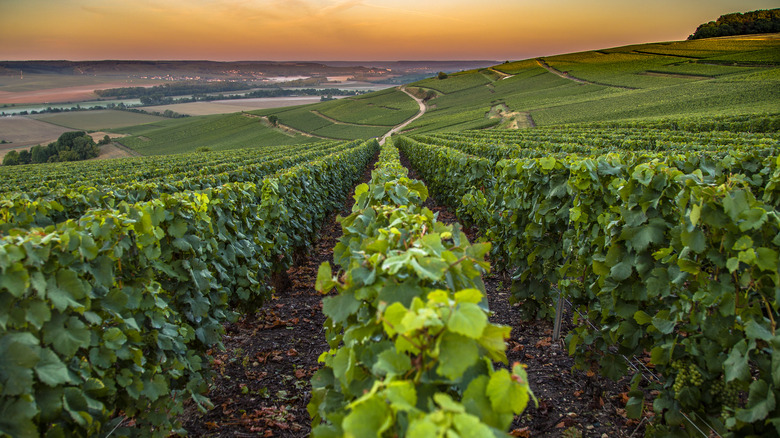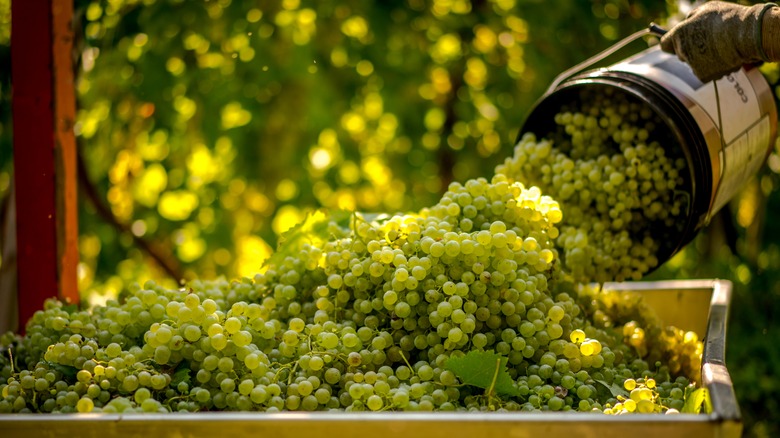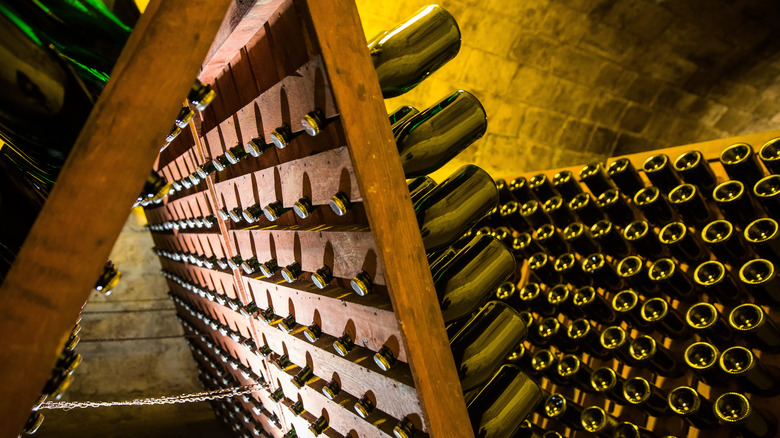There Actually Is A Difference Between Champagne And Prosecco
Next time you reach for a bottle of bubbly, you may wonder whether you should grab Champagne or prosecco. Even though they are similar, they are not interchangeable, and knowing the differences between them makes it easier to choose which one to serve.
The key differences between Champagne and prosecco are rooted in each's birthplace. Champagne comes from a specific region in France, while prosecco traditionally comes from a specific region of Italy (though today it can be made outside this zone). While this may seem like a minor difference, where the grapes are grown and where the wine is made really makes all the difference. You may have noticed that vineyards are often on slopes or even hillsides, which helps the grapes receive more direct sunlight, ensures soil drainage, and offers some protection against frost. Temperature also makes a difference as wine grapes are a little like Goldilocks and do best when they're not too hot or too cold. As a result, a vineyard's location plays a huge role in its wine production as the nutrients in the soil, the climate, and the surrounding culture all play into subtle differences in taste, mouthfeel, price point, and your experience when you raise a glass of the bubbly.
Beyond the regional differences, winemakers use different grapes, production methods, and aging techniques to craft Champagne and prosecco. In the time it could take to chill a bottle, you can learn to recognize how these subtle differences impact flavor.
Champagne must come from a specific region, prosecco is not protected yet...
Champagne hails from the Champagne region in northern France. To use the name, the wine must be a product of that specific place per French and European Union laws. The area provides a climate ideal for growing grapes with lower acidity. It's as far north and as cool as the grapes will tolerate, with a steady supply of moisture most of the year and a nice warm summer for ripening.
Prosecco wine comes from the Prosecco Hills in Northwest Italy, though the recognized zone includes Veneto and Friuli-Venezia-Giulia. The region also receives ample rain, and the mineral-rich soil provides good drainage. The climate is temperate, with warm summers. While traditional prosecco wine is a product of a specific place, it doesn't yet have the same protections as Champagne, though the European Union is moving in that direction. For now, the type of grapes used determines if a wine can be called prosecco. As such, you can find prosecco wine made from traditional prosecco grapes but grown and produced elsewhere, including neighboring Slovenia and Australia.
These wine-producing regions are considered significant, and both regions are recognized as UNESCO World Heritage Sites for their contributions to the world's "cultural landscape."
The grapes used result in different flavors
Champagne wine is usually made from a blend of grapes, including Pinot Noir, Chardonnay, and Pinot Meunier. There are other approved grapes, including Pinot Blanc, Pinot Gris, and even a newer fungus-resistant hybrid grape called Voltis that are used but not as common as the big three mentioned. All the grapes are grown in the Champagne region. Blending the grapes helps maintain flavor balance as it ages.
While Champagne is blended, prosecco is primarily made from one type of grape known as Glera grapes. Some winemakers blend in other grapes like Chardonnay but at least 85% of the grapes used must be Glera. The result is a more fruit-forward wine since it can't fall back on the craft of blending grapes to create the flavor. Even though prosecco wine is named after a town in the region it comes from, as Champagne is named for the province in France, winemakers called Glera grapes "Prosecco" grapes up until 2009, which is one reason Australian winemakers have been resisting the European Union's move to legally require that wine labeled as prosecco originate in the region, per The Guardian.
The contrast between focusing on one grape versus a blend of three or more grapes affects the flavors. Prosecco usually has a light, refreshing fruit taste, while Champagne has more variable flavors, often with notes of toasted bread or biscuit. The flavor differences are partially related to the grapes used and partially due to the production methods.
The different ways Champagne and prosecco are made
The subtle variations in flavor and mouthfeel are also related to how Champagne and prosecco are produced and aged. Both of these sparkling wines are fermented a second time for carbonation, but otherwise, there are differences in the rest of their production.
Champagne is made through the méthode champenoise or the traditional method, which starts with winemakers making, fermenting, and aging a base wine blend. To add bubbles to this blend, it's time for the second fermenting. In this step, winemakers add sugar and yeast and seal the wine into individual bottles, letting them rest for at least nine months. As the sugar is consumed by the yeast, bubbles form and are trapped in the glass. Finally, the bottles are turned to rest vertically so any remaining yeast moves to the neck of the bottle so it can be removed before the bottles are resealed and sold.
Prosecco, on the other hand, is made using the Charmat or tank Method. After a base wine is made, it's time for the second fermentation. In this case, winemakers opt to add the base wine, along with sugar and yeast, to a large pressurized tank. Once the wine has fermented for a second time, it's divided into bottles.
Both methods create bubbly, sparkling wines, but since the traditional method is more labor-intensive as the wine is fermented in individual bottles, Champagne is often more expensive than prosecco. The traditional method also results in Champagne having smaller, longer-lasting bubbles, while prosecco has comparatively frothy bubbles. Whichever you opt for, cheers! Once you select your bubbly, you may want to turn your attention to how to chill that bottle quickly or how much to pour into each glass.



